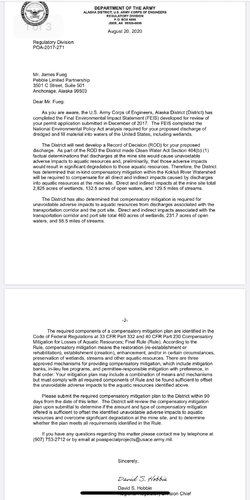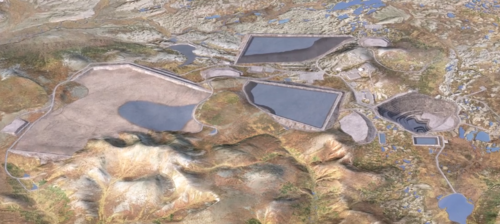Bambistew
Well-known member
So we only believe models when they suit our narrative? Insert climate change models...4) the EIS has a LOT of assumptions and the assumptions are used in the modeling, so nothing is certain, just a best educated guess. I agree permits should not be issued on popularity contests, but the analysis has so many assumptions it kind of ends up that way by default (political/popularity).
No, I didn't read the whole thing, but the executive summary is over 100 pages and no one is paying me to read it so I just "skimmed" it. All alternatives reviewed by USCOE said there will be an impact on various drainages. to quote:
Potential impacts to fish values at the mine site include: direct loss of aquatic habitat in the NFK and SFK drainages; fish displacement, injury and mortality; changes in surface water and groundwater flows that could impact fish spawning, rearing, and off-channel habitat; increased sedimentation and turbidity instreams; impacts to fish migration; changes in surface water temperatures; and changes to surface water chemistry. In summary, development of the mine sitewould permanently remove approximately 99 miles of streambed habitat in the NFK and SFK drainages.
None of the impacts can be quantified in time or magnitude. Again, best educated guess says this is going to have a negative environmental impact. I don't need to cite any studies to refute anything because the summary lays it out. It's all there.
No one is paying me either, but if I'm going to have an opinion on it I'm going to form my own, not take someone else's word for it. Like I said no one reads anything, its too much work...
I'm not denying that there will be loss of habitat, but its a tiny piece of habitat of the entire region. Alaska isn't MT the entire state shouldn't be a friggn national park, at statehood we settled that and gave up 40% of the state as national parks/preserves. And you are right, there is no way quantify the loss, but we can make assumptions/estimates as to what it will be. The end result could result in more habitat or rehabilitation elsewhere in the drainage per requirements of the permit. The water management plan will likely result in stabilized flows in the streams throughout the year that will very highly increase spawning and rearing habitat in the NFK drainage. Imagine if the habitat loss was offset by a 2-3 fold increase in usable habitat? Here is a comparison. Pebble will impact about 2400ac of wetlands (what the previous administration's EPA allowed, BTW). The city of Anchorage has destroyed over 8000ac, and I have no clue how many hundreds of miles of spawning/rearing habitat. The turbidity of every stream in the municipality is degraded, etc etc. I don't like making comparisons, but it is what it is. There has been little to no reciprocal replacement of those lost wetlands and extinct fisheries. This is in no way a comparision to what Pebble would do on a drainage wide basin. Anchorage has destroyed entire basins. The COE also notes that the loss of salmon would be unmeasurable because of the size and variability of runs. There is 100,000's of miles of rearing streams in the drainage. Again going back to the dooms-day all ocean killing mine, its impossible to even quantify the loss of fish because it so small. How will it destroy the Bristol Bay Fishery?
Another quote:
The EPA assumed that if the infrastructure for one mine is built, it would likely facilitate the development of other mines, and for the purposes of their study assumed that six additional mines would be developed
There is no guarantee this does or doesn't happen, but it was in the EPA's research because it was reasonable. So it's not just the Pebble project, it the potential for more development once the infrastructure is in place.
Well, they'd have to find a resource for them to develop a mine, at this point there hasn't been much found. The infrastructure "could" support up to 6 mines, not will. Kind of like saying a road has capacity for 100 cars per hour, but only sees 10.
We are talking about whether the benefit outweighs the costs (here is where we disagree, I'm sure of that). We don’t need any more gold. The US isn’t on the gold standard anymore and we just printed a few trillions of dollars in the blink of an eye and the World didn't care. Copper is an industrial metal and the price has been stable. It has been between $2 and $3 for years and China's use really determines pricing in the metal. This mine doesn't have a need from a US strategic point of view. Consequently, my view is let someone else mine it; Chile, Peru, Mexico, etc. You say "They only understand that dams fail and believe that everything related to mining is “toxic.” " I agree that dams rarely fail in catastrophic fashion, but they leak- a lot. The area is also active for earthquakes and volcanic activity (which is why the copper is there), which increase the chance of problems. And mining is toxic. To extract copper from the ore you have to pass sulfuric acid over it so the copper dissolves. Sounds "toxic" by my definition. I presume this mine is going to do the same thing, but correct me if I'm wrong.
Your idea of benefit/need is pretty different than the worlds, but I see you point. The price of gold is up 20% since the printing of that money... mostly because the dollar devalued. As the price goes up, other projects become viable as well at lower grades, however those at higher grades become even more valuable. I do agree, we don't need more gold, but the world sees it differently. As to the point of copper prices not increasing, the demand has increased about 5% a year. The price has remained stable because we are offsetting demand by mining more of it. There hasn't been a large copper mine permitted in a long time, those mines don't produce for ever and have a finite production, and the % copper in reserve declining and the price will very likely surge in the coming future, or that's the idea. Similar to "peak oil" they are predicting "peak copper." I do think that technology will reduce the amount of copper used/needed in the future, but as the push for electric cars and other "renewable" energy sources continues to surge, the amount of copper needed is going to continue to increase, and likely substantially. We can not recycle our way out of it yet. Something like 90% of all copper mined is currently in the production cycle, and demand.
Let other countries mine, sounds good until we piss off the rest of the world and stop exporting. As far as strategically not needed, yeah, probably not at this point, but at the rate that mines are depleting reservs, and the lack of permitting new mines, at some point we could be in the position.
The dam is designed to leak, and be collected. Leakage is easy to contain/collect. As far as your earthquake catastrophe, thats a red herring. There are thousands of dams built in and around fault lines that have withstood massive quakes. You're showing your lack of dam building expertise. Rockfill dams are the safest of all dams when it comes to earthquakes. Lastly, there is no active fault near the mine, the dam is designed as if there is. Its all in the EIS. You mention volcanoes, what happens when one goes off and kills off all the fish area wide? Its happened for eons, and the fish persist. The stuff coming out is just as "toxic" or more so than anything that would come from the mine. Maybe this is why the fishery is so prolific?
My conclusion is purely from my personal point of view. I don't live in Alaska and I don't work on the project, so I don't care how much money they might make on the mining lease or payroll taxes. Selfish? yes. I would rather we leave it and enjoy the natural resources and generate revenue that way.
I don't fault you for your opinion. I wish Big Sky, and Bozeman would burn to the ground, and we could go back 40 years. MT is an awful place to live. They've destroyed one of the best places in the world with development, and eco-tourism along with untold ac of wetlands, and streams and fish and polluted rivers. Its easy to point out one project, but impossible to quantify the destruction of an entire ecosystem, where everyone is responsible.
I don't think anyone is complaining about the cost to do reclamation. Bonding is the safeguard against superfund sites. Some states are behind (cough Montana), but others are at the forefront. Bonds are priced to cover the worst case scenario that could likely happen, but not some far fetched pie in the sky scenario, like a nuke hitting a dam, or some massive failure.Regarding bonding, every mine isn't a problem but it has to be pricing like it will become a problem. A google search of superfund sites will list a lot of mines. People can complain about the cost of EPA regulations but I like clean air and water and as a citizen, don't want to pay every time some engineering assumption goes wrong. Like I said earlier, the high cost of the the regulation has pushed our pollution to other countries and we get cheaper prices too. I would rather we come up with cleaner ways to do this, but Americans love a good deal and they don't like recycling. How this mine could possibly be cheaper than collecting copper from all the broken down equipment sitting on ranches in Montana is beyond my comprehension.
A cleaner way to mine? We're getting there, and maybe with technology we can, or we can reduce our footprint/use of minerals. But until the rest of the world climbs out of their third world economy, its not happening.







